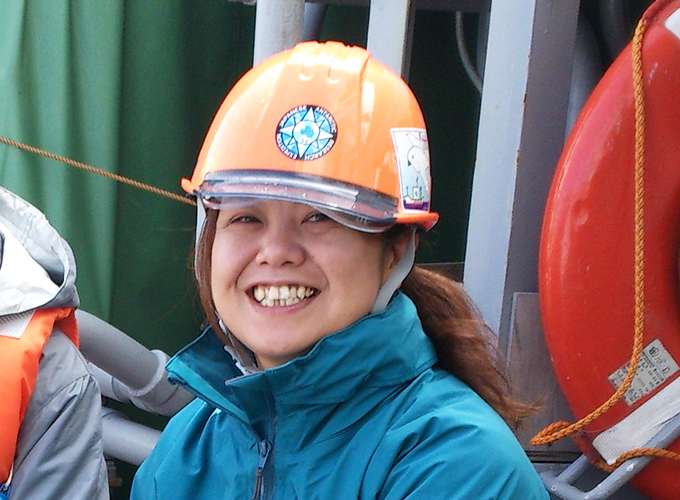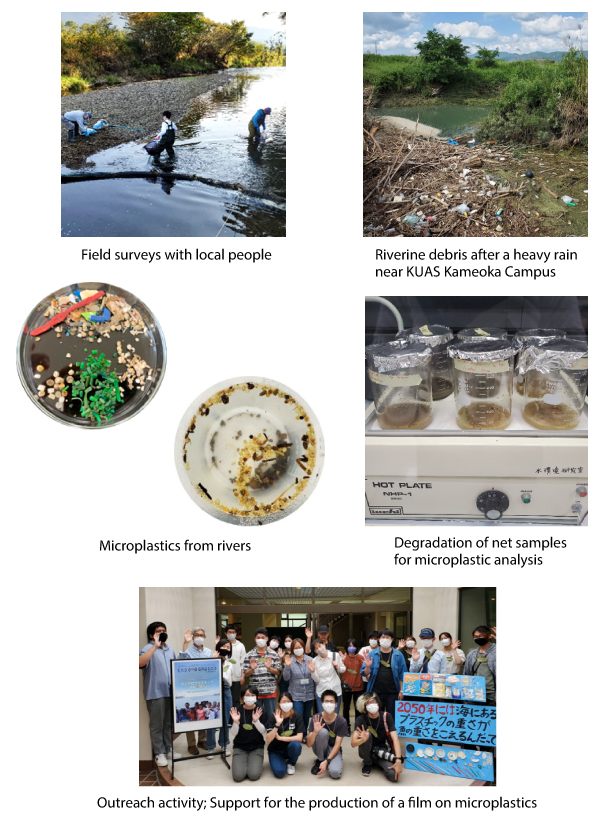Nobue Kasamatsu-Takasawa
Associate Professor, Ph.D. in Science
- takasawa.nobue

- Areas of Research
- Biological Oceanography, Biogeochemistry
- Profile
- Research
-
Dr. Nobue Kasamatsu-Takasawa was born in Fukui City, Fukui Prefecture. When she was in elementary school, she took a boat trip from Fukui to Hokkaido for a project implemented by Fukui City. From that time on, she knew that she wanted to live in Hokkaido in the future, and she believed that Hokkaido University was the only university that would allow her to do so, and the only one of the Hokkaido University faculties that would allow her to pass the entrance exam was the Faculty of Fisheries. With that, she chose the Faculty of Fisheries for her undergraduate studies. While learning basic chemical analysis and water quality research methods as an undergraduate, Dr. Takasawa became interested in the environment and biogeochemical cycles. With a desire to study them, she entered the master’s program at the Graduate School of Global Environmental Chemistry, Hokkaido University. It was here that she encountered “DMS” (dimethyl sulfide).
DMS is a sulfur compound produced mainly by phytoplankton in the ocean and is thought to influence global climate change. This encounter was the catalyst that drove her to the North Pacific, the Southern Ocean, and even Antarctica. She became interested in studying the effects of environmental changes on ecosystems and DMS distribution and entered the doctoral course at the Department of Polar Science, School of Multidisciplinary Sciences, The Graduate University for Advanced Studies (SOKENDAI). At this institution, she could conduct research in the Antarctic Region, where changes in the environment and climate are more likely to occur. She went to the Southern Ocean and Antarctica to conduct research and obtained a Ph.D. in ecology and DMS formation processes in the Southern Ocean.
Dr. Takasawa had a vague idea that she wanted to study the global environment when she was a high school student, but she would never have imagined at the time that her studies would bring her as far as Antarctica.She currently lives with her family in Kameoka City, Kyoto. Since her son is still small, she cherishes the time she spends with family. She loves to cook and enjoys eating even more. She cooks on weekends, but she feels that she is not too good at it and that it is too time-consuming. When her child is older, she would like to enjoy her hobbies of diving and mountain climbing with them.
-
“Dr. Takasawa’s research focuses on the protection and conservation of water environments from the perspective of water resources, keeping in mind the interactions between living creatures and the environment in the hydrosphere. Through field surveys in various water environments in the Kansai region, (e.g. the Lake Biwa-Katsura River system, Osaka Bay, the Yura River to the Japan Sea, familiar rivers and agricultural reservoirs), she studies 1) the effects of human activities on these water environments, 2) the relationship between water quality(environment) and living organisms, and 3) material cycles in the water environments. She is considering ways to achieve a better water environment without placing a burden on the environment.
In particular, Dr. Takasawa has recently been focusing on plastic debris in rivers and microplastics in the aquatic environment. In recent years, ocean plastic pollution has become an issue, and it is said that more than 70% of the plastic in the ocean comes from land. Generally, it is thought that the larger the city, the more plastic is discharged, but she wondered if there is a specific discharge of plastic waste from rural areas as well, so her lab conducted research on riverine debris with Kameoka City. When investigating drifting debris in the Katsura River tributaries around Kameoka City, they found the possibility that a significant amount of microplastics was created from drifting debris while in the Hozu River tributaries, which are located in the very upper reaches of the Yodo River system.
Dr. Takasawa’s lab is also investigating covered fertilizers used in rice paddies as a source of agriculturally derived microplastic dynamics. In general, many of the capsules covering fertilizers are made from biodegraded plastics in soil, but it is said that it takes several months to years in the paddy fields for them to decompose. From the investigations in university plots and surrounding rice paddies, it was supposed that many covered fertilizer capsules can be discharged into rivers on the way to decomposition, but some farming methods can prevent microplastics from leaking before they decompose.
Based on the results, and by cooperating with researchers in other fields and local residents, Dr. Takasawa’s lab hopes to counter plastic pollution in the ocean from inland areas. Furthermore, they are working with companies to develop analytical instruments that can be used for environmental education and outreach activities.What Dr. Takasawa wants people to learn through our research on the water environment is that human beings cannot live by human alone. In nature, there is a system of interaction between living things, materials, and the environment, and humans live comfortably thanks to the benefits of this system, but there are still many things we do not understand about this system. Therefore, once a part of that system is destroyed by humans, it is difficult to restore it. If a part of the mutual circulation system is destroyed, we will have to artificially protect the environment, and we will have to invest a lot of resources and energy. In order to prevent such a situation, Dr. Takasawa believes that the idea of understanding and respecting the already existing living world and environment and acquiring the wisdom to make good use of their power, will become increasingly important for human beings to continue to lead richer lives.”
